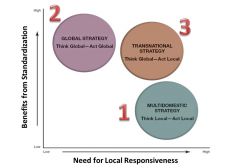![]()
![]()
![]()
Use LEFT and RIGHT arrow keys to navigate between flashcards;
Use UP and DOWN arrow keys to flip the card;
H to show hint;
A reads text to speech;
20 Cards in this Set
- Front
- Back
|
Why Do Companies Decide to Enter Foreign Markets?
|
1) To gain Access to New Customers
2) To achieve Lower Costs & enhance the Firm's Competitiveness 3) To further exploit its Core Competencies 4) To gain access to Resources & Capabilities 5) To spread its Business Risk across a Wider Market Base |
|
|
how and why differing market conditions across countries influence a company's choices in international markets
|
Competing Across National Borders makes Strategy Making More Complex
1) Different countries have different home-country advantageous in different industries. 2) Impact of location-based value chain advantages, government policies and political conditions, economic conditions and currency exchange rates. 3) Differences in buyer demographics, tastes and preferences for products and services. |
|
|
Home Country Advantage Principles:
The Diamond of National Advantage |
Demand Conditions: home market size and growth rate; buyers' tastes
Firm Strategy, Structure, and Rivalry: Different styles of management and organization; degree of local rivalry Factor Conditions: availability and relative prices of inputs (e.g. labour, materials) Related and Supporting Industries: proximity of suppliers, end users, and complementary industries |
|
|
Value Chain Influencing Factors
|
Lower wage rates
Higher worker productivity Lower energy costs Fewer environmental regulations Lower tax rates Lower inflation rates Tax incentives Low tax rates Low-cost loans Site location and development Worker training Exchange rates Proximity to suppliers and technologically related industries Proximity to customers Lower distribution costs Available\unique natural resources Environmental regulations subsidies and loans to domestic competitors Import restrictions Tariffs and quotas Local-content requirements Regulatory approvals Profit repatriation limits Minority ownership limits |
|
|
Consumer Preference Impact Factors
|
Customized Products Strategy
Standardized Product Strategy |
|
|
Terms:
Political Risks Economic Risks |
Political risks stem from instability or weakness in national governments and hostility to foreign business
Economic risks stem from the stability of a country's monetary system, economic and regulatory policies, and the lack of property rights protections |
|
|
5 Strategic Options for Entering & Competing in International Markets
|
1. Maintain a national (one-country) production base and export goods to foreign markets
2. Licensing foreign firms to produce and distribute the firm's products abroad. 3. Employ and overseas franchising strategy 4. Establish a wholly-owned subsidiary by either acquiring a foreign company or through a "greenfield" venture 5. Rely on strategic alliances or joint ventrues with foreign companies |
|
|
Greenfield ventrue
|
is a subsidiary business that is established by setting up the entire operating from the ground up
|
|
|
Cross-border alliances enable...
|
a growth-minded company to widen its geographic coverage and strengthen its competitiveness in foreign markets; at the same time, they offer flexibility and allow a company to retain some degree of autonomy and operating control.
|
|
|
Three main strategic approaches for competing internationally
|

|
|
|
THE QUEST FOR COMPETITIVE ADVANTAGE IN THE INTERNATIONAL ARENA
|
1. Use international location to lower cost or differentiate product.
2. Share resources and capabilities. 3. Gain cross‐border coordination benefits. |
|
|
Multi-domestic strategy |
Is one in which a company varies its product offering and competitive approach from country to country in an effort to be responsive to differing buyer preferences and market conditions, It is a think-local, act-local type of international strategy, facilitated by decision making decentralized to the local level
|
|
|
Global strategy
|
Is one in which a company employs the same basic competitive approach in all countries where it operates, sells much the same products everywhere, strives to build global brands, and coordinates its actions worldwide with strong headquarters control. It represents a think-global, act-global approach.
|
|
|
Transnational strategy
|
Is a think-global, act-local approach that incorporates elements of both multi-domestic and global strategies
|
|
|
Advantages and Disadvantages for a Multi-domestic Approach
|
Advantages
-can meet the specific needs of each market more precisely -can respond more swiftly to localized changes in demand -can target reactions to the moves of local rivals -can respond more quickly to local opportunities and threats Disadvantages -hinders resource and capability sharing or cross-market transfers -higher production and distribution costs -not conducive to a worldwide competitive advantage |
|
|
Advantages and Disadvantages for a Transnational Approach
|
Advantages
-offers the benefits of both local responsiveness and global integration -enables the transfer and sharing of resources and capabilities across borders -provides the benefits of flexible coordination Disadvantages - more complex and harder to implement - conflicting goals may be difficult to reconcile and require trade-offs -implementation more costly and time-consuming |
|
|
Advantages and Disadvantages for a Transnational Approach
|
Advantages
-lower costs due to scale and scope economies -greater efficiencies due to the ability to transfer best practices across markets -more innovation from knowledge sharing and capability transfer -the benefit of a global brand and reputation Disadvantages -unable to address local needs precisely -less responsive to changes in local market conditions -higher transportation costs and tariffs -higher coordination and integration costs |
|
|
Profit Sanctuaries
|
and country markets that provide a company with substantial profits because of a strong or protected market position
|
|
|
Cross-market subsidization
|
supporting competitive offensives in one market with resources and profits diverted from operations in another market - can be a powerful competitive weapon
|
|
|
Concept of Mutual Restraint
|
When the same companies compete against one another in multiple geographic markets, the threat of cross-border counterattacks may be enough to deter aggressive competitive moves and encourage mutual restraint among international rivals
|

